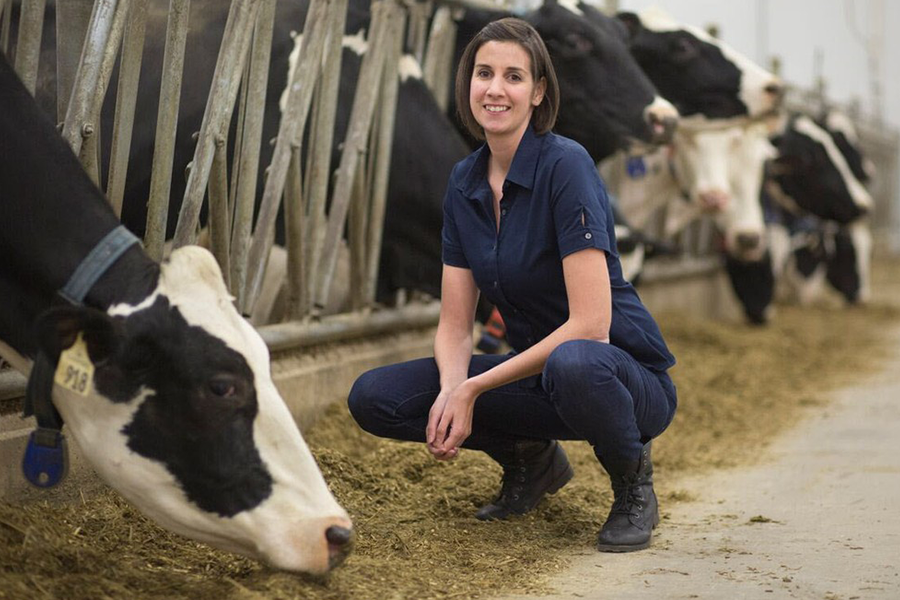
More than manure
Where most people see a field of manure, Jennifer Town sees the future of green energy.
By Federica Giannelli
Town, who recently earned her PhD in veterinary microbiology at the University of Saskatchewan, has studied microbes—tiny organisms—that "eat" manure and other organic waste while producing methane as a byproduct.
When spread on the land, manure naturally releases methane, a potent greenhouse gas, and may also contain microorganisms that contaminate watersheds.
But if the manure is contained in anaerobic digesters, the giant bucket-like facilities where it can decompose, the methane generated becomes a gold mine for powering and heating anything from cars to buildings.
"Renewable methane production can reduce our dependence on fossil fuels," said Tim Dumonceaux, a U of S adjunct professor in the veterinary microbiology department and Town's supervisor.
Methane production technology has seldom been adopted in North America because it's not currently economically feasible. That's because the quantities of gas produced in digesters vary greatly and little is known about how to stabilize the process.
Town has found a way to improve the efficiency of these facilities.
She tracked the microbes in the digesters that are critical for gas production by using a next-generation DNA sequencing-based technique developed by a Canadian team including U of S researchers and federal agencies.
By making production more reliable, Town's research could promote the adoption of renewable methane technology among large-scale cattle producers, enabling them to become more energy self-reliant. They could use the methane for their households and businesses, while disposing of manure and other organic waste in an environmentally friendly way.
Funded by Natural Resources Canada and Agriculture and Agri-Food Canada, Town's research is a turning point. By surveying the composition of the groups of microbes in digesters, she has found that different microbial groups digest manure at each stage of production.
"If the balance of these groups is skewed, the process breaks down and no methane will be produced," Town said.
She also isolated the best methane-producing microbes that had diverse genes for methane production. She found in lab trials that when added to stalled digesters, these organisms were able to boost the proportion of methane produced from zero to 75 per cent.
"Now we can improve control over methane production by making it a more predictable and economically feasible technology in Canada," Town said.
She has published her results in the journals Bioresource Technology and Applied Microbiology and Biotechnology, and presented her findings at an international conference in Vienna, Austria.
Because her research required specialized lab equipment to track the microbes, Town's next goal is to develop a user-friendly, portable tool to monitor the type and quantity of microbes in digesters. If the funding is approved, she will use the pilot-scale facilities of Prairie Agriculture Machinery Institute (PAMI) in Humboldt for the project.
Article written by Federica Giannelli, a graduate student intern in the U of S research profile and impact unit. This article first ran as part of the 2015 Young Innovators series, an initiative of the U of S Research Profile office in partnership with the Saskatoon StarPhoenix.
When spread on the land, manure naturally releases methane, a potent greenhouse gas, and may also contain microorganisms that contaminate watersheds.
But if the manure is contained in anaerobic digesters, the giant bucket-like facilities where it can decompose, the methane generated becomes a gold mine for powering and heating anything from cars to buildings.
"Renewable methane production can reduce our dependence on fossil fuels," said Tim Dumonceaux, a U of S adjunct professor in the veterinary microbiology department and Town's supervisor.
Methane production technology has seldom been adopted in North America because it's not currently economically feasible. That's because the quantities of gas produced in digesters vary greatly and little is known about how to stabilize the process.
Town has found a way to improve the efficiency of these facilities.
She tracked the microbes in the digesters that are critical for gas production by using a next-generation DNA sequencing-based technique developed by a Canadian team including U of S researchers and federal agencies.
By making production more reliable, Town's research could promote the adoption of renewable methane technology among large-scale cattle producers, enabling them to become more energy self-reliant. They could use the methane for their households and businesses, while disposing of manure and other organic waste in an environmentally friendly way.
Funded by Natural Resources Canada and Agriculture and Agri-Food Canada, Town's research is a turning point. By surveying the composition of the groups of microbes in digesters, she has found that different microbial groups digest manure at each stage of production.
"If the balance of these groups is skewed, the process breaks down and no methane will be produced," Town said.
She also isolated the best methane-producing microbes that had diverse genes for methane production. She found in lab trials that when added to stalled digesters, these organisms were able to boost the proportion of methane produced from zero to 75 per cent.
"Now we can improve control over methane production by making it a more predictable and economically feasible technology in Canada," Town said.
She has published her results in the journals Bioresource Technology and Applied Microbiology and Biotechnology, and presented her findings at an international conference in Vienna, Austria.
Because her research required specialized lab equipment to track the microbes, Town's next goal is to develop a user-friendly, portable tool to monitor the type and quantity of microbes in digesters. If the funding is approved, she will use the pilot-scale facilities of Prairie Agriculture Machinery Institute (PAMI) in Humboldt for the project.
Article written by Federica Giannelli, a graduate student intern in the U of S research profile and impact unit. This article first ran as part of the 2015 Young Innovators series, an initiative of the U of S Research Profile office in partnership with the Saskatoon StarPhoenix.

